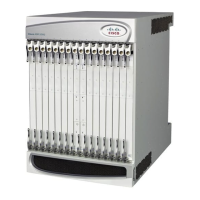▀ Features and Functionality - Base Software
▄ Cisco ASR 5000 Series Product Overview
A total of 20,000 simultaneous LI triggers can be provisioned on the Cisco P-GW. Cisco‘s LI solution is currently
interoperable with leading mediation solutions from a number of partners.
Important: For more information on Lawful Intercept support, refer to the Lawful Intercept Configuration
Guide.
Local Break-Out
Provides a standards-based procedure to enable LTE operators to generate additional revenues by accepting traffic from
visited subscribers based on roaming agreements with other mobile operators.
Local Breakout is a policy-based forwarding function that plays an important role in inter-provider roaming between
LTE service provider networks. Local Breakout is determined by the SLAs for handling roaming calls between visited
and home networks. In some cases, it is more beneficial to locally breakout a roaming call on a foreign network to the
visited P-W rather than incur the additional transport costs to backhaul the traffic to the Home network.
If two mobile operators have a roaming agreement in place, Local Break-Out enables the visited user to attach to the V-
PLMN network and be anchored by the local P-GW in the visited network. The roaming architecture relies on the HSS
in the home network and also introduces the concept of the S9 policy signaling interface between the H-PCRF in the H-
PLMN and the V-PCRF in the V-PLMN. When the user attaches to the EUTRAN cell and MME in the visited network,
the requested APN name in the S6a NAS signaling is used by the HSS in the H-PLMN to select the local S-GW and P-
GWs in the visited EPC network.
Subscriber Level Trace
Provides a 3GPP standards-based session level trace function for call debugging and testing new functions and access
terminals in an LTE environment.
As a complement to Cisco's protocol monitoring function, the P-GW supports 3GPP standards based session level trace
capabilities to monitor all call control events on the respective monitored interfaces including S5/S8, S2a, SGi, and Gx.
The trace can be initiated using multiple methods:
Management initiation via direct CLI configuration
Management initiation at HSS with trace activation via authentication response messages over S6a reference
interface
Signaling based activation through signaling from subscriber access terminal
Note: Once the trace is provisioned it can be provisioned through the access cloud via various signaling interfaces.
The session level trace function consists of trace activation followed by triggers. The time between the two events is
treated much like Lawful Intercept where the EPC network element buffers the trace activation instructions for the
provisioned subscriber in memory using camp-on monitoring. Trace files for active calls are buffered as XML files
using non-volatile memory on the local dual redundant hard drives on the ASR 5000 platform. The Trace Depth defines
the granularity of data to be traced. Six levels are defined including Maximum, Minimum and Medium with ability to
configure additional levels based on vendor extensions.

